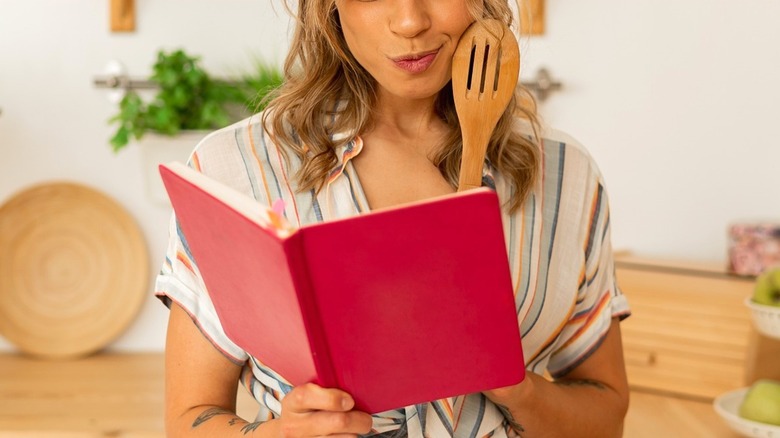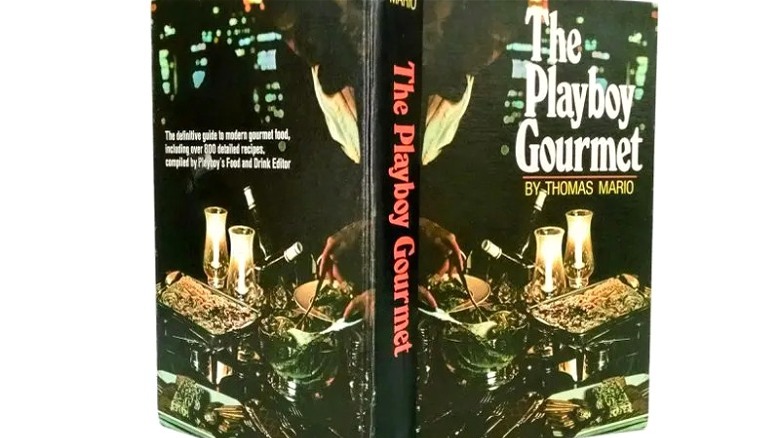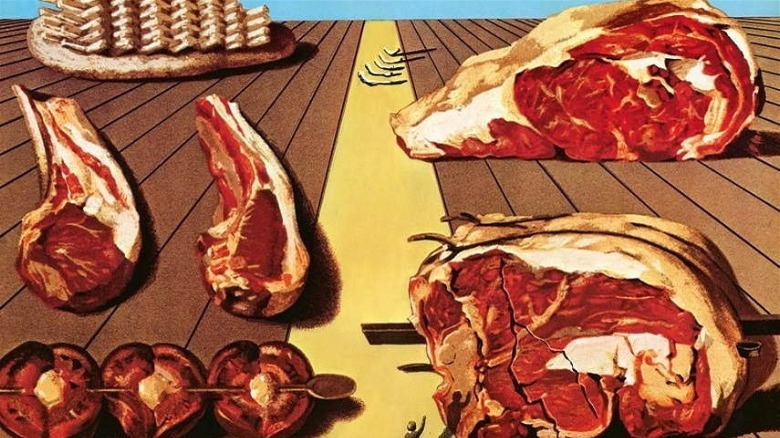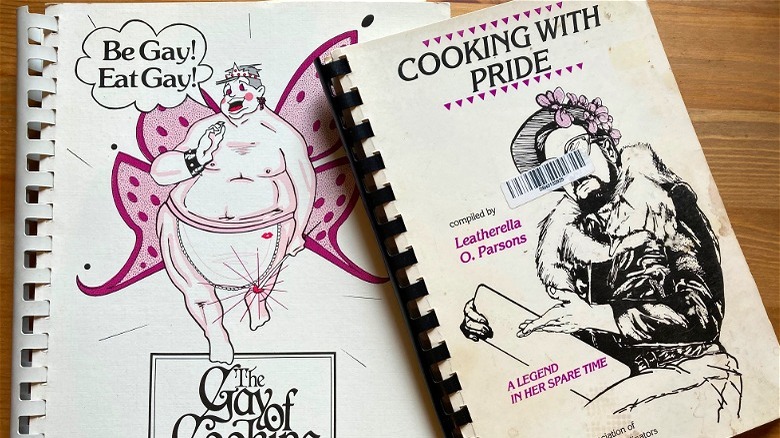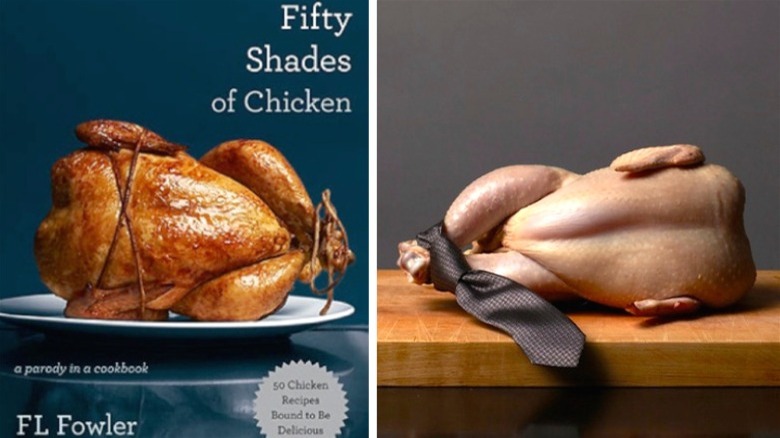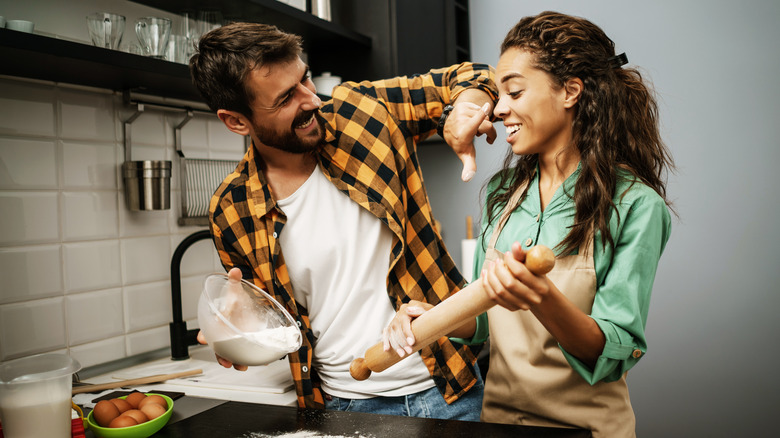The Truth About Erotic Cookbooks
We may receive a commission on purchases made from links.
Cooking is a hobby many people have come to love and enjoy, especially over the last few years with the rise and decline (and rise again) of the COVID-19 pandemic (per FOODDIVE). With all this precious time spent in the kitchen, it would make sense to have a trusty shelf dedicated to the highest-rated cookbooks, ready to assist whenever you're prepared to take that risk capacity to the next level.
Yet, have you considered moving past your proverbial brink into uncharted territory? It's common knowledge that some people enjoy spicy foods and it's also a known fact that some enjoy spice in the bedroom. But what about the combination of the two as a fluid concept and finding it in the cookbook section of your local Barnes and Noble?
According to author Vicki Leon (per The Marginalian), the connection between food and sex has been linked back to the Roman Empire, yet erotic cookbooks began making their mark on history throughout the 20th century (via Eater). Now with vintage cookbooks returning to the stage for their cultural value and imagery (per Financial Times), erotic cookbooks old and new are making their way to younger generations, showcasing the gendered history that took place all throughout the 1900s.
While erotic cookbooks aren't for everyone, they do have their place and serve a meaningful purpose — aside from their whimsy BDSM references and pun-filled banter.
The early history of erotic cookbooks
Apart from the 1960s list of popular foods that are making a comeback in 2022, erotic cookbooks didn't make their debut in the world until that decade was born. Though, according to Katharina Vester, author of "A Taste of Power: Food and American Identities," the stage was already being set for the culmination of these peculiar books at the end of the 19th century when men increasingly began working outside of the home due to the industrial revolution (via YouTube).
The kitchen was then reshaped into a primarily female-dominated space. However, with men still cooking from time to time, they needed an angle to safely enter this sector without risking their masculinity. Cue the early erotic cookbooks written for the male chef!
According to Esquire, "The Playboy Gourmet Cookbook" came out in 1961, armed not only with Hugh Hefner's favorite recipes but included his commentary on seducing female guests.
While most cookbooks that focused on sex during this time were aimed at men, chef and author Mimi Sheraton paved the way for women to stand on equal ground when it came to undercover foreplay with her book "The Seducer's Cookbook." Beyond the unique recipes, Sheraton's goals for writing the book included more sex in America with women feeling comfortable welcoming that prospect (via The Marginalian).
Free love and the connection to food
The 1960s marked the beginning of erotic cookbooks, but it was "just the tip" when it came to works that pushed people out of their comfort zones. With the women's rights movement underway in the 1970s, there was also a sexual explosion of free-thinking among women and their right to speak up for what they wanted in the bedroom (per CNN).
This newfound ideology led to erotic cookbooks that focused more on equal opportunity satisfaction — such titles include "What's for Breakfast" and "Lewd Food: The Complete Guide to Aphrodisiac Edibles." While these titles may be milder in content, some catered to other hidden and not-so-hidden kinks such as "Cooking For Orgies and Other Large Parties."
While you are most likely familiar with using aphrodisiacs to amplify a meal, something you may not know is that even surreal artist Salvador Dali jumped on board and wrote a cookbook in the 1970s titled "Les Diners de Gala" which focused on the intrinsic link between taste and pleasure (per WIDEWALLS).
As the decade rolled on, Playboy also continued making moves in the culinary world by starting a food-centered column in the popular sex-focused magazine in 1978. This spurred the original Food & Wine publication, which became a separate enterprise, undergoing new ownership in 1983 and 2013 (per Food & Wine).
With all of this equality-enforced change happening with food and sex, most books within this early time frame have heteronormative undertones, which led to the birth of an entirely new set of erotic cookbooks for marginalized communities.
Erotic Cookbooks for and by the LGBTQ community
The first cookbook written for a marginalized audience was "The Gay Cookbook" which was published in 1966 by Lou Rand Hogan years before the Stonewall Riots took place and the talk of gay rights was even in mainstream society's peripheral view. The purpose of the book, according to Hogan, was to present the gay man as one who enjoys life, happily maintaining a domestic role: an image that was absent from mainstream culture during the 1960s and 1970s.
In the late 1980s, spiral-bound books were compiled by Leatherella Parsons of people in the LGBTQ community that wanted to share their recipes as a way of building up the marginalized community. The book "Cooking With Pride" acted as a fundraiser of sorts to get support out for queer contributors (via The Historical Cooking Project).
When it comes to bars and restaurants, there are plenty out there that are highly rated for the LBGTQ community. Though not as advertised in mainstream culture, since the 1990s, many books have also been published by members of the LGBTQ community with and without erotic undertones. "The Lesbian Erotic Cookbook" was published in 1998 not only with recipes, but with poems and stories for the reader to enjoy while "The Queer Cookbook" — which came out in 1996 — had a special section of recipes and tonics for those suffering from HIV and AIDS (per the Historical Cooking Project).
Members of the LGBTQ community were able to harness community activism through their recipes and visions in history while today, people of the nonbinary and transgender community can find their voices through cookbook publication (per Book Riot).
Erotic Cookbooks in the 21st century
Gender roles have long been a contentious factor when you consider the beginning of erotic cookbooks to where they are now, especially in regards to content and authorship. Among the most popular in today's current market are titles like "Romancing the Stove: The Unabridged Guide to Aphrodisiac Foods" and "Intercourses: An Aphrodisiac Cookbook."
In an interview regarding "Intercourses," co-author Martha Hopkins discusses her ideology around the book's sexy foods, detailing the significance of allowing oneself to experience all five senses at once (per StarChefs). Hopkins states, "Take honey. It connotes golden, drippy, sticky, sweet. It looks beautiful when you pour it. Smells good."
Whether you like honey straight up or the hot variety dripped on all those warm gooey dishes, there is also a book available for your reading pleasure titled "Honeylingus: 50 Healthy Honey Recipes That Will Leave You Begging for More."
Sex and food have also entered mainstream culture in parody form with the release of "50 Shades of Chicken." We have come a long way when you consider the popular lists of erotic cookbooks ranked by Fox News and Hum Nutrition.
Most of the books mentioned entail couples or pleasing one another in food form, not simply the seduction of male to female. Some of the books listed focus on the overall physique of the human body (i.e. "The Shredded Chef") and ways to enhance your appearance by eating the right foods. It still begs the question, what drives someone to write an erotic cookbook?
Erotic cookbooks are the product of self-expression
When it comes down to the naughty details of these so-called erotic recipe books, it's not all golden showers: behind the jokes and sexy imagery, there is real meaningful content that authors wish to share. Andreas Carver, author of an erotic cooking zine in North Carolina, released his work as a way of communicating his experience growing up mixed-race and queer in the south (per The Charlotte Observer). In Martha Hopkins' interview regarding "Intercourses," she mentions that each recipe has a panel of commentary from those who have tried each dish indicating the importance of community (per StarChefs).
While erotic cookbooks haven't been around since the dawn of time, the notions behind them have. While there are a plethora of dessert options out there to try before you die, the demand for sex-shaped baked goods, particularly cakes, is on the rise (via Grub Street). This comes as no surprise when you know the reason behind the shape of the beloved Italian cannoli (per BBC). And the rise in demand for vintage books and penis-shaped donuts makes sense, given the decreased value society holds on personal appearance (via Eat This, Not That!). People are going to express themselves the way they want.
Whether it's getting turned on by someone allowing you to eat raw fish off their chest or discovering your newest must-try romp position through suggestively positioned cookies (per "The Cookie Sutra"), erotic cookbooks have given people another avenue to express themselves in their communal love of food and sex.
